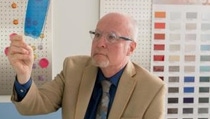Media
What does the color of your car say about you?
Head of design for BASF North America, Automotive Coatings, explains the profound effect of vehicle paint colors.

For those who think the shade of their vehicle has no underlying meaning, think again. When people choose the color for their car, they are, in fact, telling the world something about who they are.
“If you see yourself as a fast or sexy person, you might want a bright red color on your car,” said Paul Czornij, head of design at BASF’s Color Excellence Group, in an interview. “Or if you want to exude power or sophistication, you might put out a black metallic on your car.”
But car paint color goes far beyond self-expression or a whimsical fashion statement. It reflects more profound societal trends, such as how they work psychologically with people. The color blue, for instance, is said to have a direct connotation to nature, but it also works subliminally as it is the shade of trust and loyalty, according to Czornij.
Czornij’s job is creative, but nevertheless demanding. Each year, he and other BASF designers conduct global research, uncovering overarching trends and regional differences that impact society today and determine how those sentiments will influence customers’ vehicle color preferences down the road. He then designs colors based on predictions for the future of car colors, for a design book with 65 samples of what BASF believes will be popular in the next four to five years in different regions. The chemical giant develops the samples based on a wide array of data including research of trends in art, architecture and pop culture. The annual study from BASF’s Coatings Division helps manufacturers prepare for future auto paint colors.
“Color is very emotional and a very driven aspect of what people put on their cars,” said Czornij. “I try to capture the information I get from the trends research and turn that into color that is a bit more conservatized, because car colors tend to be more conservative than say what you see on cell phones, textiles or in the fashion industry.”


According to the BASF Automotive Color Trends 2018/19 report, this year's theme is "Keep It Real"—the need to stay authentic in a world where technology continues to blur the lines between reality and artificiality. Aimed at guiding auto manufacturers, the chemical company identified shades of gray and blue as the focal point of the color collection this time around. The connection of the real and virtual world as well as the relationship of earth and space is captured in BASF’s key color in North America, Atomium Sky: a deeply saturated blue with a medium coarseness that transitions to a softer, semi-opaque hue in longer grazing angles. The color exudes playfulness and demonstrates a futuristic spirit and forward-thinking, accordign to the report. This is the second consecutive year that BASF has selected blue as its key color in North America, which is a result of its growing prominence in the region.
BASF annual trends report’s job is to not only find what color is trending now, but also to predict what will be in vogue three to five years from now, as that is how long it takes to engineer the auto colors.
Per Czornij, the Coatings Division looks at three main categories in determining the color of the times. Those categories include the following:
· The tech world—The team monitors if there’s a particular color that’s showing up in technology. “We wanted to see how the tech world is blending the digital and analog; how virtual/augmented reality could relate to that,” said Czornij;
· Society—They observe what societies are doing, is there an optimism or pessimism of the times? “Societies have a way of reacting to colors, or maintaining color preferences,” he added. “You can pick things up like culture or heritage, and how culture may link specifically to a particular color space;” and
· Individual—How the technology and society influence the individual.
In North America, for instance, Czornij and team found that the dismantling of public heroes makes room for new idols. Flaws are accepted as part of being human and diversity is celebrated. A new enthusiasm for science and especially space travel draws attention to far away worlds, according to BASF.
While there are four BASF design studios located in different regions, including Europe, Asia Pacific and South America, the chemical company plans to invest $40 million over the next two years in its auto coatings production in North America.
“BASF continues to strive to be number one in color, that’s part of our vision for 2025,” Czornij concluded. “Color design is a key aspect of that. We need to understand the pulse of what’s happening in society and technology, and also other industries and process that into automotive color.”
Published by Anna Spiewak.
For media inquiries or to repurpose this article, please contact Lisa Brown.